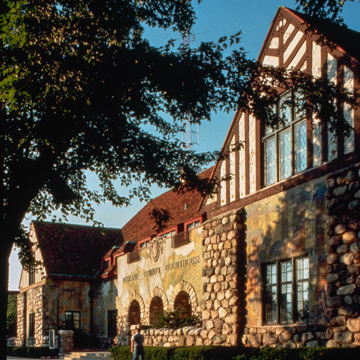In the 1920s county voters approved three bond issues to construct a new courthouse replacing the first, a small, frame structure built in 1856. Herbert H. Dow, founder of Dow Chemical Company, offered to assist in financing the building if he were allowed a free hand in the selection of architect, artist, and design. The result was a county courthouse unique in Michigan, and one described at the time of its opening in January 1926 as reflecting a “modified Tudor” or “Tudor country house” style.
The courthouse is distinctive for the residential appearance that Tuttle (1889–1936) of Detroit and Cleveland created and for its softly glistening exterior wall murals painted by Paul Honoré (1885–1956) of Detroit. The murals, executed with thick layers of a new material—“Magnesite Stucco” (a mixture of magnesium oxyphloride cement and colored glass) developed in the Dow Company laboratories and applied with a palette knife—depict various human forms, pine trees, and abstracted backgrounds; the murals were restored in 2005–2006. The key interior public space, the second circuit courtroom, is highlighted by a segmental-arched vaulted ceiling, walnut woodwork and dais screen, and an additional mural by the building's artist.















